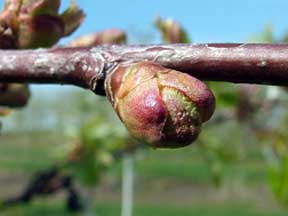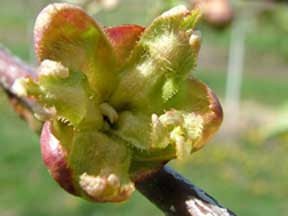Winter injury in sweet cherry in northwest Michigan, 2008
Editor’s note: This article is from the archives of the MSU Crop Advisory Team Alerts. Check the label of any pesticide referenced to ensure your use is included.
Winter damage has been observed in sweet cherries in the northwest as well as other regions of the state. Growers first noticed this damage because trees had no bloom. The trees look brownish and relatively bare compared to those with a true full bloom. The branches are covered with large reddish buds that feel empty to the touch (Photo 1). When these oversized buds open, there is nothing inside the buds, giving the damaged trees a brown appearance with few visible blossoms (Photo 2). This damage is likely due January 2008 weather when we had temperatures ranges from the mid-40s to single digits in a 12-hour time period. We believe that the injury showing up now in sweet orchards is a result of this mid-winter damage.
The next question is how to manage damaged trees this season to maximize tree health for the future. To begin, growers should assess the level of damage, as this measurement will guide their management decisions for the 2008 season. If growers do indeed have no bloom, a minimal pesticide spray program would save money and time. Sprays for cherry leaf spot are still warranted to maintain healthy leaves for photosynthesis throughout the season. However, with no fruit on the trees, growers will not need to spray for fruit-infesting insects such as plum curculio and cherry fruit fly. Additionally, American brown rot sprays can be limited as there will be no fruit for the Monilinia pathogen to infect. The dilemma is that most orchards are not likely to have a total loss of fruit. Therefore, if a small amount of fruit is present, insecticide and fungicide sprays are still warranted as pest infestation and fungal infection this season can lead to higher insect populations and increased fungal inoculum for 2009. Another potential problem is that certain varieties appear to have been hit harder than others (i.e., Schmidt), and in mixed blocks, growers would have to apply a standard spray program for only the undamaged cultivars in the block; limiting treatment for damaged cultivars may not prove cost and time effective.
Fertilizer recommendations will not vary greatly between orchards with and without damage. However, if nitrogen (N) applications have not yet been made this season, growers could reduce the N at this time. Trees will need some N to for growth, but with no fruit (which contribute greatly to N demand during the growing season) there will be more available N for tree growth. In short, the N that would have been used in fruit growth will go into tree growth. If blocks have no crop, growers could reduce N by 30 to 40 percent. Partial crops should receive the same N level as a full crop. If the crop is extremely light, growers could reduce N a small amount (approximately 10 percent).
In terms of pruning strategies for trees with winter damage observed this spring, no special techniques are required. Vegetative buds will likely have stronger growth because both overwintering reserves and new carbohydrates from current season photosynthesis that would have gone to early fruit formation and development will be used by the vegetative growing points. Stronger vegetative growth often occurs when trees suffer from winter damage compared to spring frost damage. Often only the floral ovary is killed by frost, and the otherwise undamaged flowers still use reserves for the bloom period even if the rudimentary fruit ultimately aborts.
Lastly, trees with few blossoms this year will have strong return bloom in 2009. Trees with few fruits and strong vegetative growth will lead to increased flower production the following year. Growers may want to prune a bit harder in dormancy to prevent overcropping, especially on varieties that have a tendency to set heavy crops (i.e., Ulster or Napoleon) or for cherries that will be used for the fresh market, since the proportion of small-sized fruit increases with heavy croploads.



 Print
Print Email
Email



